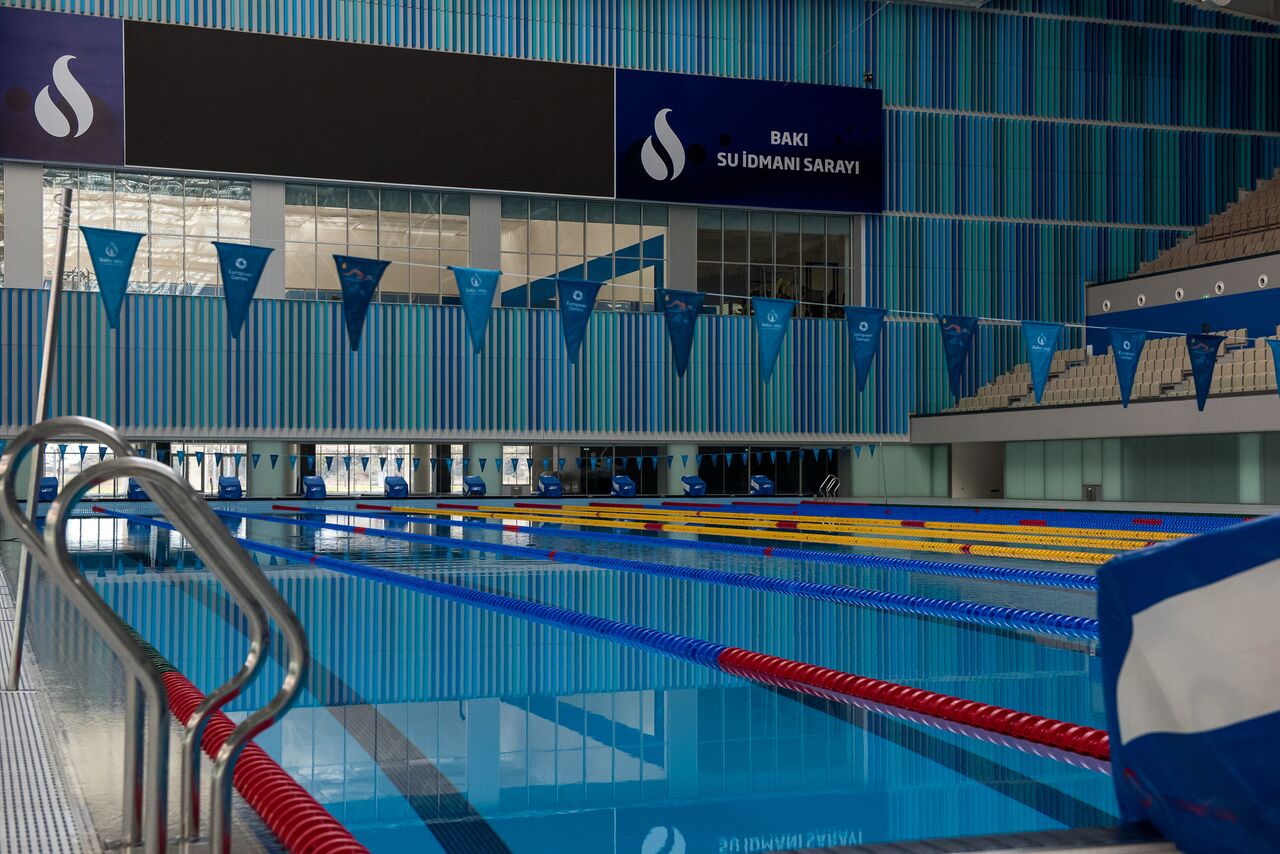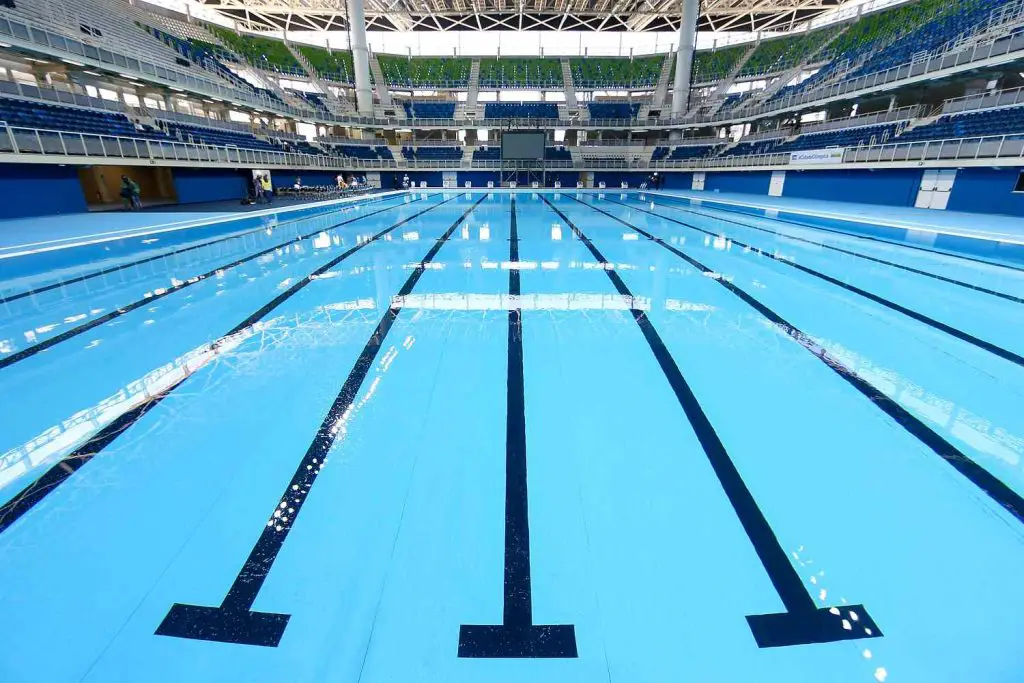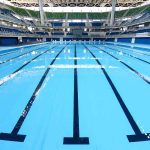An Olympic size pool is 50 meters long and 25 meters wide, with a maximum depth of 2 meters. Olympic size pools are large and standardized, providing an ideal venue for competitive swimming events.
The dimensions of these pools allow athletes to showcase their skills and push their limits in a controlled and regulated environment. Olympic swimming pools are carefully designed to meet the specifications set by international governing bodies, ensuring fairness and consistency in the sport.
These pools are meticulously maintained and offer optimal conditions for swimmers to achieve their best performances. Whether it’s the excitement of the swimming races or the dedication of the athletes, Olympic size pools play a crucial role in the incredible spectacle of the Olympic Games.

Credit: en.wikipedia.org
History Of Olympic Size Pools
When it comes to the history of Olympic size pools, it’s fascinating to explore how these iconic swimming venues have evolved over time. From the origins of Olympic size pools to the evolution of their dimensions, the journey of these aquatic centers is both intriguing and impressive.
Origins Of Olympic Size Pools
The origins of Olympic size pools can be traced back to the early 20th century when the need for standardized swimming facilities became evident. The first recorded Olympic size pool was built for the 1924 Paris Olympics. This marked a significant shift in the world of aquatic sports, as it set a benchmark for future swimming competitions.
Evolution Of Pool Dimensions
Over time, the dimensions of Olympic size pools underwent refinement to meet the requirements of competitive swimming. The standard dimensions of an Olympic size pool have been set at 50 meters in length, 25 meters in width, and a minimum depth of 2 meters. These specifications ensure uniformity and fairness for swimmers participating in international events.
Standard Dimensions Of An Olympic Size Pool
The standard dimensions of an Olympic size pool are crucial to ensuring that it meets the requirements for international competitions. These dimensions not only determine the size of the pool but also play a significant role in maintaining uniformity across various Olympic venues. Understanding the specific measurements of an Olympic size pool can help in the planning and construction of such facilities.
Length
The length of an Olympic size pool is 50 meters.
Width
The width of an Olympic size pool is 25 meters.
Depth
The depth of an Olympic size pool ranges from 2 meters to 3 meters.
Comparison To Other Pool Sizes
When assessing the vastness of an Olympic size pool, it’s beneficial to understand how it compares to other pool sizes. Let’s delve into the differences in size and the impact these dimensions have on competitions.
Differences In Size
The magnitude of an Olympic size pool stands out when compared to standard pool sizes. Below table illustrates the variations:
| Type of Pool | Length | Width |
|---|---|---|
| Olympic Size Pool | 50 meters | 25 meters |
| Standard Pool | 25 meters | 12.5 meters |
Impact On Competitions
- An Olympic size pool influences the intensity of competitions by requiring swimmers to cover greater distances.
- This larger pool size demands more stamina and strategic planning from athletes.
- The increased dimensions can lead to enhanced performances and record-breaking achievements.
- Competitions in Olympic size pools are known for showcasing top-level athleticism and skill.
Construction Challenges
The construction challenges of building an Olympic-size pool are immense due to its large dimensions. With a length of 50 meters, a width of 25 meters, and a depth of at least 2 meters, these pools require careful planning and execution to meet international standards.
Constructing an Olympic size pool is no small feat. The sheer size and depth of these pools present several construction challenges that need to be overcome. Let’s take a closer look at two crucial aspects of building an Olympic size pool: Excavation and Installation, and Maintenance Costs.
Excavation And Installation
Excavating and installing an Olympic size pool requires careful planning and precision. The process involves the following steps:
- Site Selection: Finding a suitable location is the first step. It needs to meet certain criteria, including adequate space and access to utilities.
- Excavation: The ground needs to be excavated to create a large enough space for the pool. This process involves removing soil and rocks.
- Foundation Preparation: Once the excavation is complete, the site needs proper preparation for the pool’s foundation. This may involve compacting the soil and adding a layer of gravel or concrete.
- Installation: The pool components, such as the walls, floor, and plumbing systems, are then carefully installed to create a strong and efficient structure.
Maintenance Costs
Maintaining an Olympic size pool involves significant costs to ensure its safety and functionality. Some key factors contributing to maintenance costs include:
- Water Treatment: Keeping the water clean and balanced is crucial for the health and comfort of swimmers. This involves regular testing, filtration, and chemical treatments.
- Energy Consumption: Pumps, heaters, and lighting systems consume a considerable amount of energy. Employing energy-efficient equipment can help reduce costs.
- Repair and Renovation: Over time, the pool may require repairs due to wear and tear. Renovations may also be necessary to meet changing regulations or upgrade facilities.
- Staff and Training: Employing trained personnel to manage and maintain the pool is an ongoing cost. Lifeguards, pool technicians, and administrative staff are essential for smooth operations.
Uses Beyond Competitive Swimming
Olympic size pools offer more than just a space for competitive swimming. Explore the various uses beyond traditional laps and races.
Aquatic Events
Dive into a world of exciting aquatic events, such as water polo and synchronized swimming competitions.
Training Facilities
Professional athletes utilize Olympic size pools as training facilities to hone their swimming skills.

Credit: en.wikipedia.org
Innovations In Pool Design
Technological advancements and eco-friendly features have transformed the design and functionality of Olympic size pools. From cutting-edge technology to sustainable innovations, these enhancements have revolutionized the way we experience swimming.
Technological Advancements
With the rapid evolution of technology, Olympic size pools have embraced various advancements to enhance the swimming experience. The integration of state-of-the-art pool management systems has made it easier to maintain water cleanliness and temperature control. Additionally, innovative underwater lighting systems have improved the aesthetics of these pools, creating a captivating ambiance for swimmers.
Eco-friendly Features
In response to the need for environmentally sustainable solutions, Olympic size pools now incorporate various eco-friendly features. These advancements aim to reduce energy consumption and minimize environmental impact. From solar-powered heating systems to energy-efficient pumps and filters, these pools uphold a commitment to sustainable practices.
Global Spread Of Olympic Size Pools
Discover the widespread presence of Olympic size pools worldwide. These immense pools measure in at 50 meters long, catering to professional swimmers and lovers of aquatic sports. From bustling cities to remote resorts, these pools continue to make a splash globally.
Olympic size pools are not limited to the Summer Games alone. They have grown in popularity across the globe, catering to both competitive swimmers and recreational users. These massive pools have become a symbol of prestige and excellence in various communities worldwide.
Proliferation Of Facilities
The establishment of Olympic size pools is on the rise, with many countries investing in top-notch facilities to nurture local swimming talent. These pools attract elite athletes and enthusiasts alike, fostering a culture of health and fitness in their surrounding areas.
Community Impact
Olympic size pools serve as more than just sports venues; they act as community hubs that bring people together. These pools host events, swim meets, and training sessions, creating a sense of camaraderie among participants and spectators.

Credit: blog.chloramineconsulting.com
Future Trends In Pool Size
As urban spaces become more congested, the demand for smaller, innovative pool designs is on the rise. This has led to a shift in the traditional concept of Olympic size pools.
Adaptation To Urban Spaces
In response to the limited space available in urban areas, architects and pool designers are adapting their approaches to accommodate smaller, yet functional, pool sizes. This adaptation has opened up opportunities for creative and unconventional pool designs that integrate seamlessly into urban environments.
Miniaturization Vs. Standardization
Miniaturization is gaining traction as a trend, with a focus on compact, space-efficient pool designs. However, the debate between miniaturization and standardization continues, with some advocating for standardized sizes to maintain consistency in competition and training facilities. The industry is exploring ways to balance the demand for smaller pools with the need for standard dimensions that align with international regulations.
Conclusion
Olympic size pools are a vast 50 meter long swimming space that’s iconic. Hosting events around the globe, they remain a symbol of excellence and competition. Understanding their dimensions adds depth to our appreciation of this elite sporting realm. Dive into their greatness!





